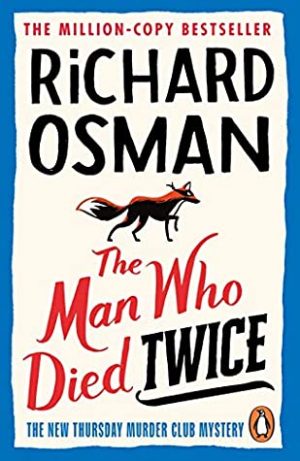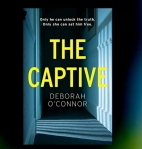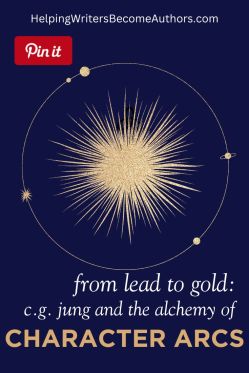 Storytelling is a mystical crucible. Just as the ancient alchemists sought the transformation of base metals into gold, writers strive for the metamorphosis of their characters’ inner selves throughout the story. Alchemy, as explored through the lens of Carl Jung’s insights, can elevate your characters from the leaden weight of initial flaws to the gleaming brilliance of transformation.
Storytelling is a mystical crucible. Just as the ancient alchemists sought the transformation of base metals into gold, writers strive for the metamorphosis of their characters’ inner selves throughout the story. Alchemy, as explored through the lens of Carl Jung’s insights, can elevate your characters from the leaden weight of initial flaws to the gleaming brilliance of transformation.
Last fall, I spent part of my month-long writing retreat in the Berkshires auditing a series of online lectures from the Centre of Applied Jungian Studies. These lectures from leading Jungian experts, collected under the heading “The Mystery School,” explored revolutionary depth psychologist C.G. Jung’s writings and theories about how ancient alchemy stands as a metaphor for psychological transformation. Throughout, my excitement grew as I recognized that the four intrinsic parts of the alchemical/analytical process are also reflected in (surprise!) story structure.
Some of you may remember I posted about this Instagram.
A post shared by KM Weiland (@authorkmweiland)
So what is alchemy, and why should writers care? For me, one of the most delightful mysteries of life is how, when you start paying attention, the theories of story structure and character arc show up everywhere. Not only is this interesting in applying the wisdom of story to life, it also creates opportunities to learn how to tell better stories by examining systems that, at first glance, seem to have nothing to do with fiction.
The series of lectures I watched focused on Jung’s recognition that the four parts of alchemy naturally aligned with his own four tenets of analysis and personal transformation. Even though I teach a Three Act structure, this structure divides story into four equal parts. Particularly when examined from the perspective of character arc, these four parts align naturally and perfectly with the four parts of alchemy/Jungian analysis. The pattern deepens!
I’ve written before about how writers can apply various theoretical models (such as the Karpman Drama Triangle and the Enneagram) to storytelling. Alchemy is yet another window through which to view story. It offers a tool to help us shape our stories into greater verisimilitude. Plus, if you’re a pattern hunter, as I am, it’s just cool!
Today, I invite you to explore the parallels in these systems and to glean new insights into how to craft psychologically resonant stories. I’m just beginning to scratch the surface of this comparison myself and can’t wait to share more about it in the future. For now, here are some of the parallels.
The Four Stages of Alchemy
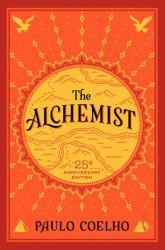
The Alchemist by Paulo Coelho (affiliate link)
Apart from Paulo Coelho’s beautiful fable The Alchemist, most of us probably aren’t super-familiar with the ancient ideas of alchemy. Put simply, the alchemists believed they could discover a scientific method for turning lead into gold. Great tomes were written about their experiments, although there was never any evidence of success (until modern science).
As time went on, Jung and others began to posit that alchemy was really a metaphor for psychological transformation in which the lead of the self may be refined into a higher state of “gold.” In later life, Jung studied and theorized extensively about how the principles of alchemy could be utilized as archetypal wisdom for furthering the analytic process.
Although alchemy can be broken down into further stages, the four main ones are as follows:
1. The Nigredo: The Blackening
In functional alchemy, this represented the burning away of the initial base dross. The goal was to remove all impurities in a return to the “prima materia” (the original pure) and to emerge with the golden Philosopher’s Stone.
Psychologically, the Nigredo represents the beginning of transformation. It is the Dark Night of the Soul, the death that creates the opportunity for rebirth. It is a period of recognizing and facing one’s shadow as the first step toward integration and wholeness. (And for more on the shadow, check out my brand new email course Shadow Archetypes: Writing Complex Fictional Characters!)

2. The Albedo: The Whitening
The second step is that of further purification, as the alchemist takes steps to wash away impurities after the Nigredo phase and/or shine a light upon the work to highlight further impurities. Here, the lead becomes silver.
Psychologically, the Albedo represents the beginning of individuation. The period is marked by a recognition of two separate entities that emerged during the confrontation with the shadow in the previous stage and which now invite a movement toward union.
3. The Citrinitas: The Yellowing
The third step signifies the appearance of a yellow or gold color. This stage is often associated with the idea of the sun rising, symbolizing the infusion of warmth and light into the alchemical work.
Psychologically, Citrinatus can be interpreted as the emergence of enlightenment, spiritual insight, or a higher state of consciousness. It suggests a progression toward the culmination of the alchemical journey, where the transformative process takes on a radiant and luminous quality.
4. The Rubedo: The Reddening
The final step represents the culmination of the Great Work, or Magnum Opus. Rubedo is characterized by the appearance of a vibrant red or gold color, symbolizing the attainment of perfection (i.e., the Philosopher’s Stone). This stage is associated with the union of opposites, the integration of purified elements, and the realization of spiritual rebirth. The alchemist, having undergone the challenges of the preceding stages, achieves the highest level of transformation and transmutation.
The Rubedo is a symbol of the soul’s journey toward self-realization and the ultimate goal of alchemy: the reunion and reintegration of soul and psyche into a unified whole.
The Four Stages of Jungian Analysis
Amongst Carl Jung’s mountainous legacy of work, his application of alchemical symbolism to his own systems of psychological analysis and transformation are among the most intriguing. Earlier, he developed a four-part approach to what he called analytical psychology, which he describes in the Collected Works of C.G. Jung, Vol. 16:
Analytical psychology is defined as embracing both psychoanalysis and individual psychology. This approach includes four stages: confession, elucidation, education and transformation.
Jungian psychological analysis involves a profound exploration of the individual’s psyche. The process begins with an examination of conscious experiences, dreams, and symbols in a quest to uncover personal and collective unconscious elements. Archetypes play a crucial role in understanding recurring themes and patterns. The analyst facilitates the individuation process, guiding the individual toward integrating these unconscious elements with the conscious mind.

Writing Archetypal Character Arcs (affiliate link)
This holistic approach aims for a harmonious relationship between the ego and the unconscious, fostering self-awareness and personal growth. Symbolic exploration, dream analysis, and the recognition of archetypal motifs contribute to a deep understanding of the individual’s unique journey toward self-realization and psychological wholeness.
Via his own interest in alchemical texts, Jung eventually realized a comparison between his four stages of analytical philosophy and the four primary stages of alchemy.
1. Confession
Jung:
In the first stage, the secrets or inhibited emotions, analogous to repressed sins that lead to neuroses, must be confessed to enable the patient to regain his wholeness, and his dependence on the doctor, transference, must be severed.
According to Stephen Anthony Farah, MA, co-chair of the International Association of Jungian Studies, and presenter of one of the lectures:
The stage of confession/catharsis in the psychoanalytic process is symbolised in alchemy as the stage of Nigredo…. This is the intellectual function of perception.
2. Elucidation
Jung:
Next the elucidation of this transference must take place and the patient’s fixation analyzed….
Farah:
The stage of elucidation or illumination in psychoanalysis is symbolised in alchemy as the stage of Albedo…. The intellectual function of discrimination.
3. Education
Jung:
The importance of drawing the patient out of himself in a process of education in order to attain normal adaptation is stressed.
Farah:
The stage of education or insight in psychoanalysis is symbolised in alchemy as the stage of Citrinitas…. This is the intellectual function of reason.
4. Transformation
Jung:
The fourth stage, transformation, is seen to affect both patient and doctor, whose personalities have interacted throughout the treatment. Emphasis is placed on the doctor’s need to engage in self-education and to understand that both he and the patient are in search of a cure that involves not just the body but the entire psyche.
Farah:
The final stage in the process in psychoanalysis is the stage of transformation, symbolised in alchemy as the stage of Rubedo…. And this is the intellectual function of completion.
The Four Stages of Story Structure
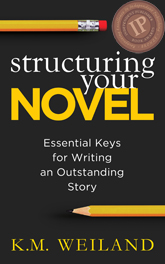
Structuring Your Novel (Amazon affiliate link)
And that brings us to the mysteries of story structure. Although story structure may be approached through systems that utilize any number of acts, the reality is that almost any model of story structure can be found to have an underlying foundation of four equal parts. I teach these parts (as part of a Three-Act system) using the following terms. (For a more thorough explanation of all these terms, check out my book Structuring Your Novel.)
1. The First Act
This is the first quarter of the story, in which the primary task is that of Set-Up, as the protagonist’s world and situation is introduced and developed. Like Nigredo, the story begins with a problem that must be solved. It signifies that change is ripe to happen in the character’s life.
This section of the story features the Hook at the very beginning and the Inciting Event halfway through (around the 12% mark). It ends with the First Plot Point as the Threshold of No Return between the Normal World of the First Act and the subsequent Adventure World of the Second Act.
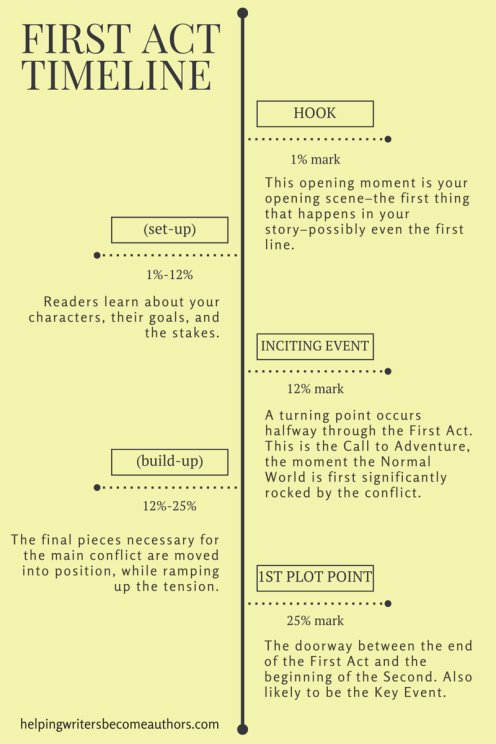
2. The First Half of the Second Act
As the second quarter of the story, the First Half of the Second Act spans from the First Plot Point at the 25% mark to the Midpoint at the 50% mark. It is divided by the First Pinch Point at the 37% mark. The First Half of the Second Act represents a period of Reaction, in which the protagonist must respond to the conflict introduced in the First Act.
It correlates to the Albedo as a time of purification, as the protagonist refines methods for overcoming the conflict and achieving the plot goal.
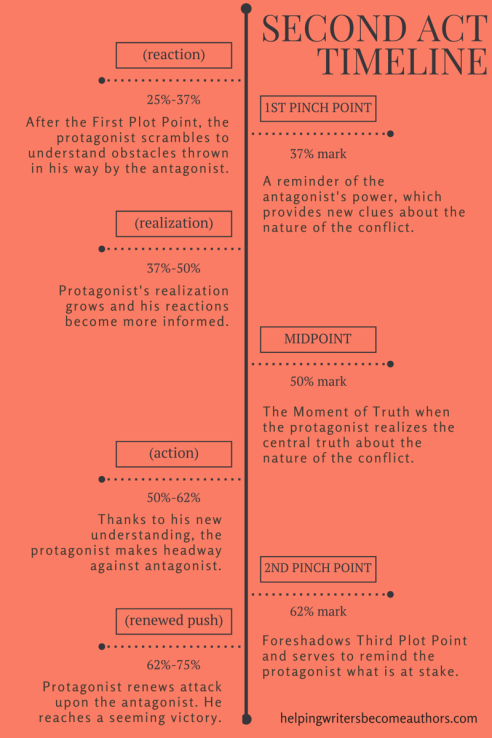
3. The Second Half of the Second Act
Initiated by the Midpoint at the 50% mark, the Second Half of the Second Act represents a period of Action. Utilizing the insights gained in the Midpoint’s Moment of Truth, the protagonist shifts out of the Reaction of the previous section and into a period of Action that spans the next quarter of the story until the Third Plot Point at the 75% mark. It is divided by the Second Pinch Point at the 62% mark.
Like Citrinitas, the Second Half of the Second Act, represents a “brightening” of the protagonist’s potential within the conflict. The trials of the previous two sections are beginning to bear fruit in the external plot as the character makes more informed and effective choices about how to proceed toward the goal.
4. The Third Act
Beginning with the Third Plot Point at the 75% mark, the Third Act represents the final quarter of the story. It begins with a period of Recovery, in which the protagonist adjusts to the startling new level of responsibility demanded by the events of the Third Plot Point. It ends with a period of Confrontation, leading to the Climactic Moment, in which the story’s conflict is decided by a final confrontation between protagonist and antagonistic force.
Like Rubedo, the Third Act represents the culmination of the entire process and, if successful, the emergence of a new status quo in both the character’s inner and outer worlds.
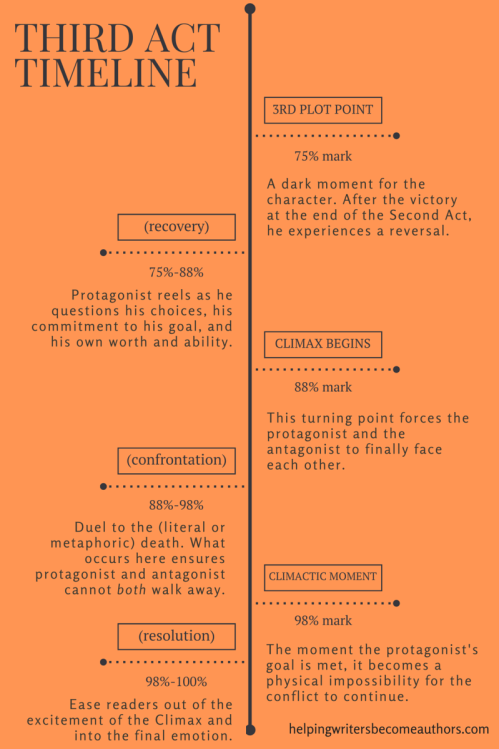
The Four Stages of Character Arc

Creating Character Arcs (Amazon affiliate link)
And now we get to the really juicy stuff! After all, what is character arc if not psychological transformation and, therefore, alchemy? (For a more thorough exploration of all the following terms, check out my book Creating Character Arcs.)
1. The Lie the Character Believes
Like the Nigredo, a Positive-Change Arc begins in the darkness and heaviness of the Lie the Character Believes. This is a limited perspective of the world that, although it may once have been reasonably functional, is now creating dysfunction in the character’s ability to move through the world in a positive way. To maintain it would inevitably create destruction. The irony is that overcoming it also necessitates a certain destruction as well, as the character destroys the self that was and builds the self that will be.
In Jung’s identification of Nigredo with the Confession phase of analysis, we can also see how the Lie the Character Believes emerges in the First Act of the story as something that is ready to be “confessed.” Up until the events that begin the story, the Lie has existed as a silent and relatively harmonious part of the character’s psyche. Up until then, there is nothing to be “confessed.” But as the Lie begins to rise to the surface as a Lie (i.e., a perspective that is no longer true), “secrets,” “inhibited emotions,” “repressed sins,” or “neuroses” may all emerge as symptoms of the impending need for change.
2. Character Begins to Explore Limitations of the Lie
In the First Half of the Second Act, the character will be challenged to explore the limitations of the Lie. Much of the “Reaction” aspect of this part of the story has to do with the character’s experimentation in new ways of seeing and being in the world. The focus here is still more on the limitations of the Lie than the possibilities of the corresponding Truth. Just as in the Albedo phase, the character is, in essence, washing away impurities over and over again, shedding bigger and bigger pieces of the Lie.
Jung identifies the Albedo with the Elucidation phase of analysis, which we see mirrored clearly here. The First Half of the Second Act is a period in which the character is learning all the ways in which the old Lie-based mindset is ineffective. More than that, the character is also beginning to learn about a contrasting Truth that offers more effective ways of achieving goals and overcoming conflict.
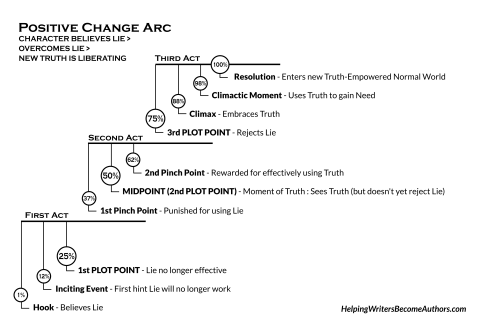
From the Creating Character Arcs Workbook.
3. Character Recognizes Truth (But Doesn’t Yet Fully Reject Lie)
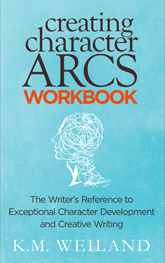
Creating Character Arcs Workbook
The Second Half of the Second Act begins with the Midpoint (or Second Plot Point). This plot point is characterized by its all-important Moment of Truth, in which the character’s efforts to overcome the Lie in the first half of the story are rewarded with a flash of insight. Symbolized by Citrinitas, this flash of insight is like the rising of the sun, bathing everything in light and understanding.
Everything learned up until this point distills into a burgeoning new perspective—the story’s thematic Truth. Throughout the Action of the Second Half of the Second Act, the character will be able to use this new grasp on the Truth to move forward more and more effectively. However, the character is not yet able to fully relinquish the old way of being. Even though the character has seen through much of the Lie, aspects of this limited perspective remain.
Jung corresponds Citrinitas with the Education phase of analysis. Unlike the previous Elucidation, which is largely something that just “happens” as a natural evolution of circumstance, the Education phase indicates the necessity of intention and will. In this Action section of the story, the character takes more and more responsibility for choices and actions rather than simply accepting and reacting to whatever happens.
4. Character Embraces New Truth
The final section of the story, the Third Act, opens with a crucible in which the character’s new Truth is tested. From there, the character must prove able to complete the transformation by fully overcoming the limited perspective of the Lie and embracing the expanded new Truth. Like Rubedo, this stage represents the achievement of perfection. In overcoming the Lie in exchange for the Truth, the character has reclaimed lost shadow parts and reintegrated them into a stronger and more cohesive whole.
Jung’s approach to analysis ends with Transformation. Story is ultimately an exploration of change in character, which is, of course, nothing more or less than psychological transformation.
***
Just as the alchemists sought the Philosopher’s Stone, writers strive for the perfect character arc. Not all stories will feature Positive-Change Arcs—and therefore won’t correspond precisely to alchemy or analytical psychology—but the patterns that emerge here offer insight into the baseline transformation upon which all character arc variations riff. Like the alchemists turning lead into gold, storytellers can transmute a character’s flaws into brilliance, revealing the profound harmony between psychological transformations and captivating narratives.
Wordplayers, tell me your opinions! What do you think is the most intriguing aspect of the alchemy of character arc? Tell me in the comments!
Click the “Play” button to Listen to Audio Version (or subscribe to the Helping Writers Become Authors podcast in Apple Podcast, Amazon Music, or Spotify).
___
Love Helping Writers Become Authors? You can now become a patron. (Huge thanks to those of you who are already part of my Patreon family!)





